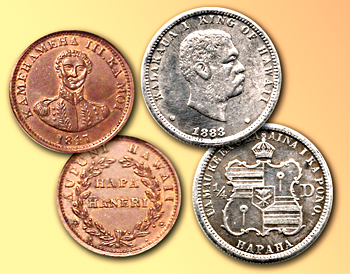Coins of the Kingdom of Hawaii
|
"Making Cents"
The Signal
Saturday, April 16, 2005
| M |
The first coinage of Hawaii was the 1-cent copper coin issued in 1847. The mintage was 100,000, which was more than adequate for a small population of the time. The coin circulated for many years until it was replaced by United States coinage in 1900.
In mint condition, this coin would bring about $2,000 at auction. The portrait was that of King Kamehameha III. In Hawaiian, the reverse reads, "Aupuni Hawaii" ("Kingdom of Hawaii") and "Hapa Haneri" ("One Penny").
In 1883, the only other circulating coins for the Kingdom of Hawaii were struck in sizes and composition matching their United States counterparts — one dime, quarter dollar, half dollar and dollar. These coins featured the portrait of King Kalakaua I.
A 5-cent coin, dated 1881, is scarce; it catalogues for $15,000 in mint condition. The most common coin available today is the 1883 quarter with a mintage of half a million. In mint condition, these sell for about $400. The half dollar, with a mintage of 700,000, is next most common; in mint condition it sells for about $1,500. The dime also catalogues for $1,500 in mint condition, and the silver dollar, $8,500. A pattern 12.5-cent piece exists, but it was never struck for circulation. Only 20 were minted in proof condition; they catalogue for $35,000.
Before these coins were struck, Hawaiians relied on various tokens and foreign coins (including United States issues). Several plantation tokens are known, and although they were meant for limited use on a given plantation, they circulated widely until the end of the 19th Century. They are quite scarce, and even used specimens catalogue for hundreds of dollars each.
Coins of the Spanish colonies in the Americas also were widely used as currency up to the end of the kingdom and the beginning of Hawaii¹s territorial status in 1900.
Imitations of the 1847 cent are sold as souvenirs at shops throughout the islands today. They have no numismatic value and are generally not very good copies of the originals. Besides, souvenir shops are not the best source for collector coins.
Dr. Sol Taylor of Sherman Oaks is president of the Society of Lincoln Cent Collectors and author of The Standard Guide to the Lincoln Cent. Click here for ordering information.
©2005, THE SIGNAL · ALL RIGHTS RESERVED.
